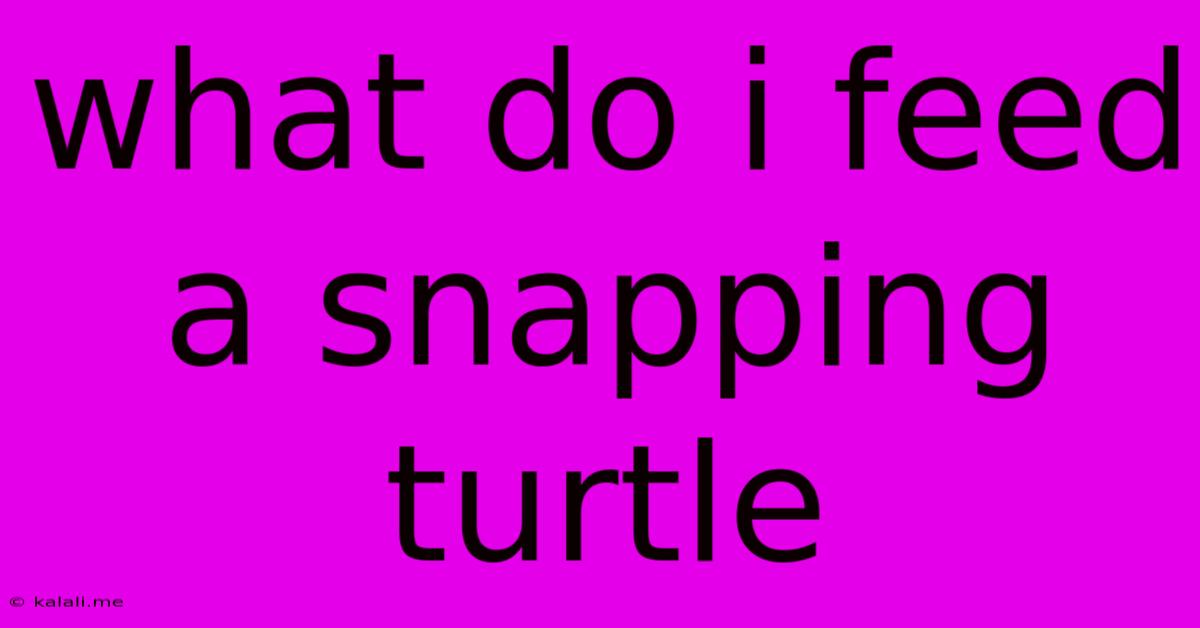What Do I Feed A Snapping Turtle
Kalali
Jun 03, 2025 · 3 min read

Table of Contents
What Do I Feed a Snapping Turtle? A Complete Guide to a Healthy Diet
Snapping turtles are fascinating creatures, known for their powerful jaws and aggressive nature. However, owning one requires responsible care, and a crucial aspect of that is providing a proper diet. This comprehensive guide will cover everything you need to know about feeding your snapping turtle, ensuring they thrive under your care. Understanding their dietary needs is key to maintaining their health and longevity.
Understanding Snapping Turtle Dietary Needs:
Snapping turtles are omnivorous, meaning they consume both plants and animals. Their diet in the wild is incredibly diverse, but their captive diet needs to be carefully managed to avoid nutritional deficiencies and health problems. The specific needs vary slightly depending on the species and age of the turtle, but generally, a balanced approach is essential.
Juvenile Snapping Turtle Diet:
Young snapping turtles require a diet higher in animal protein to support rapid growth. Their diet should consist primarily of:
- Insects: Crickets, mealworms, earthworms, and other insects provide essential protein and nutrients.
- Small Fish: Small feeder fish, like guppies, offer a good source of protein.
- Shrimp: Cooked shrimp can be a nutritious addition to their diet.
- Commercial Turtle Pellets: High-quality commercial turtle pellets formulated for young snapping turtles provide a balanced source of nutrients. These should supplement, not replace, whole foods.
Remember to vary their diet to ensure they receive a wide range of nutrients. Avoid feeding solely commercial pellets; whole foods are crucial for their overall health.
Adult Snapping Turtle Diet:
As snapping turtles mature, their dietary needs shift slightly. While still omnivorous, the proportion of animal to plant matter changes. A healthy adult diet includes:
- Fish: Larger fish, such as minnows or goldfish (ensure they are not treated with chemicals) can form a significant portion of their diet.
- Crayfish: These crustaceans provide valuable nutrients and mimic their natural prey.
- Insects: While still important, insects should be offered less frequently than in juvenile turtles.
- Carrion: While ethically sourced, this can provide valuable nutrients and mimic their wild scavenging behavior. Ensure any carrion is fresh and safe for consumption.
- Aquatic Plants: Duckweed, water hyacinth, and other aquatic plants offer fiber and essential vitamins.
- Vegetables: Certain vegetables, like leafy greens (e.g., kale, collard greens) can be incorporated sparingly. Avoid feeding excessive amounts of vegetables, as they are not their primary food source.
- Commercial Turtle Pellets: High-quality pellets for adult snapping turtles should be offered as a supplemental food source.
Foods to Avoid:
Certain foods should be avoided completely, as they can lead to health issues:
- Processed meats: These are high in fat and sodium, and lack essential nutrients.
- Dairy products: Snapping turtles cannot digest dairy products effectively.
- Bread and other human foods: These offer minimal nutritional value and can lead to digestive problems.
- Foods high in phosphorus: Excessive phosphorus can lead to metabolic bone disease.
Feeding Frequency and Portion Sizes:
- Juveniles: Should be fed daily or every other day, offering small portions to avoid overfeeding.
- Adults: Can be fed every 2-3 days, with larger portions than juveniles.
Always monitor your turtle's weight and adjust their feeding schedule accordingly. Avoid overfeeding, as this can contribute to obesity and other health problems.
Providing a Clean Environment:
Maintaining a clean enclosure is crucial for the health of your snapping turtle. Remove uneaten food promptly to prevent water contamination and bacterial growth. Regular water changes are vital to prevent the build-up of harmful substances.
By following these guidelines, you can ensure your snapping turtle receives the proper nutrition it needs to thrive. Remember to consult with a veterinarian specializing in reptiles for species-specific advice and to address any health concerns. Providing a balanced diet, a clean environment, and regular veterinary care are all key to responsible snapping turtle ownership.
Latest Posts
Latest Posts
-
What Does Ot Mean In A Text
Jun 05, 2025
-
Freezing Point Of Water At Pressure
Jun 05, 2025
-
6 Year Old Having A Lot Of Accidents
Jun 05, 2025
-
How To Remove Handle From Bathroom Faucet
Jun 05, 2025
-
Bin Bash No Such File Or Directory
Jun 05, 2025
Related Post
Thank you for visiting our website which covers about What Do I Feed A Snapping Turtle . We hope the information provided has been useful to you. Feel free to contact us if you have any questions or need further assistance. See you next time and don't miss to bookmark.